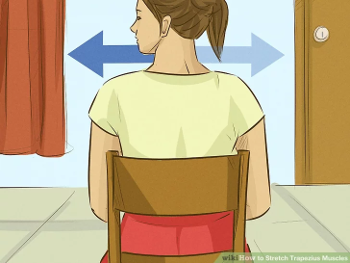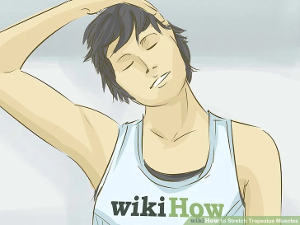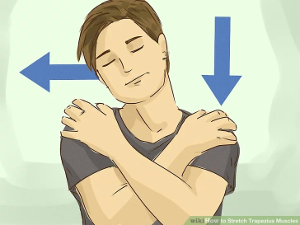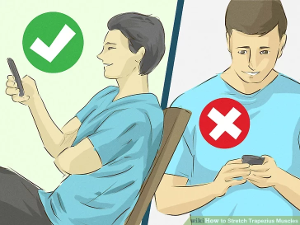What is Trapezitis & How is it Treated?
What is Trapezitis?
Trapezitis is an inflammation caused in the trapezius muscles which further leads to pain and spasm in the neck. It is increasingly becoming common among people working at desk, using computers and also those who do physical labor or use their neck and back muscles a lot. It is necessary to know the causes and symptoms of trapezitis in addition to the treatment guidelines to be able to manage the condition well.
Trapezius is a large muscle towards the back which arises from the nape of the neck. The muscle performs many main functions of our body, the most important out of them all is lifting the head upwards and shrugging off the shoulder. Apart from this, majority of muscles located in the back, also facilitates movement, rotation and stabilization of shoulder blade. The wide, flat muscle covers most of the upper back and also posterior of neck, responsible for making the back feel comfortable. However, as trapezius covers a large are, inflammation in it or trapezitis can cause severe pain and also affect the related movements.
The pain caused due to trapezitis lasts for a short period of time, which is usually between 3 to 5 days. Some of the major reasons which lead to the pain include stress and fatigue to the muscle. This is not all; bad posture is also termed as one of the major reasons of pain. Trapezitis is majorly found in individuals who are required to keep their head stable for a long period of time. Hence people working on computers for long or driving for long distance majorly suffer from trapezitis.

Causes of Trapezitis
Traditionally trapezius was termed as large muscle of neck and upper back. The name of the muscle came due to its trapezoid shape. Trapezius is made up of bands of muscle fibers. The three bands consist of superior muscle fiber band, middle and also the inferior band. When any individual suffers from inflammation in any of these three bands, it is termed as trapezitis.
Some of the common causes of trapezitis include:
- Working for a long period in the same position.
- Reading a book in an awkward position for a prolonged period.
- Driving for long distances.
- Watching television in the same or an awkward posture for long time.
- Breast feeding women too can suffer from trapezitis, especially if she bends her shoulder while feeding her baby.
- Physiotherapy in Oncology.
- Some people may also experience trapezitis, due to weak muscles of the neck and back, which may have resulted from other health conditions or injuries. Trauma, fall or blow on the neck or back can be one of the causes of trapezitis.
The above mentioned are some of the reasons which can cause strain on trapezius muscle of the body leading to acute pain and trouble. The pain is quite common in modern day life, which occurs because of overuse or improper use of muscles at workplace or home.
Symptoms of Trapezitis
Initial symptoms of trapezitis are quite mild, which shall begin with some discomfort in the neck.
Some of the symptoms of trapezitis commonly experienced by people include,
- Pain is felt at nape of neck, usually during evening or night after working hours or driving for long.
- Muscles become stiff and tight, which can only be healed or treated after the patient takes a good sleep or an effective massage.
After the early stage of trapezitis passes away, individuals are still said to suffer from problems mentioned below;
- Episodes of pain are often experienced causing pain in neck.
- There may also be difficulty in movement of neck due to spasms.
- After prolonged period of pain due to trapezitis, the pain becomes more troublesome and may appear often by the slightest trigger or strain in the trapezius.
- Pain and tightness in the neck and trapezius muscle may last for usually 3 to 5 days in an individual.
- During this phase of trapezitis, patient might also complain of pain in their arms and hands.
- In some conditions of trapezitis, particularly long standing ones, the chronic muscle spasm may also lead to nerve compression.This often results in further symptoms of trapezitis like tingling, numbness or even weakness in the arms, hands and fingers on the affected side.
Above mentioned are some of the common symptoms which can be witnessed in individuals suffering from trapezitis. If patient is seen suffering from such symptoms on regular basis, it is advisable for them to approach a professional and take a feasible treatment.
Goals of Physiotherapy:
- Improves pain through advanced modalities
- Reduces tightness
- Reduces inflammation
- Reduces spasm
- Reduces tightness
- Increases strength: resisted band exercises
- Alignment correction through manual therapy
- Taping technique
- Laser therapy for instant pain relief
- Reflexology
Physiotherapeutic Approach:
To relieve pain:
Laser therapy
Laser therapy

Evidence based practice:
Comparative Study of Myofascial Release and Cold Pack in Upper Trapezius Spasm. February Volume: vol 3 Issue: 9 Page: 2161-2166.
Transcutaneous electrical stimulation:
EVP:Effectof Transcutaneous Electrical Nerve Stimulation In Trapezitis Rajalakshmi.A International Journal of Physiotherapy and Research.

Cold pack and myofascial release:



Turn your head to the left and the right. Sit or stand up with your back and head straight. Gently turn your head all the way to the right so it’s parallel with your shoulder. Move back to the center. Repeat the motion to the right again. Do the same motion to the left, and repeat it again.[1]
- You don't need to hold the position. The movement releases tension in your muscles and may loosen up your joints.
- Muscles become stiff and tight, which can only be healed or treated after the patient takes a good sleep or an effective massage.

Stretch your neck to either side. In a seated or standing position, tilt your head to the left, keeping your nose facing forward. Place your left hand over your ear and lightly apply pressure. Use your right hand to reach behind your back from underneath. Touch your shoulder blade to ensure you’re keeping it down and to the back. Hold the position for 30 seconds.[2]
- Do the same in the other direction, tilting to the right.
- When tilting your head, don't bring it all the way down to your shoulder.

Pretend to hold a pencil between your shoulders. Stand up straight. Hold your shoulder blades back and together like you’re trying to keep a pencil there. After pulling back, press down with your shoulders, pushing them into your ribs.[4]
- Hold this position for a few seconds, then start at the beginning again. Do it several times in a row to stretch your muscles.

Wrap a wide, long belt around your back to release the tension. You can use a yoga belt or attach 2 regular belts together. Wrap it around the middle of your back, just under your upper back. Take the 2 ends in front, and toss them over the respective shoulders; the one coming out from the right should go over your right shoulder. In back again, move each end across your back and back to the front. Gently pull to tighten the straps across your stomach. As you do, you’ll help relax and release your trapezius muscles.[5]You can also buckle the belt once you have the 2 ends back in front. Tighten it as much as feels comfortable, and leave it on as long as you’d like.
Using self massage techniques

Heat the area with dry or wet heat. Try putting a heating pad over the muscle for about 20 minutes to heat it. Alternatively, try taking a warm shower or bath and immersing your shoulder muscles for 5-10 minutes.[6]
You can also make your own heating pad with things you have at home.

Knead each side of your neck with the opposite hand. Cross your left arm in front of your chest to bring your hand up to your right shoulder. With a kneading motion, rub the muscle behind the shoulder, much like kneading dough. Bring your arm slowly down the right shoulder, kneading as you go. Apply enough pressure that you can feel it, but not so much that it hurts. Repeat the process on the other side.You can repeat both shoulders 2-3 times if you want.

Rub out your knots and trigger points with your fingertips. Press down on the area that’s triggering your pain with your fingertips. Push down enough so you feel it, and then hold for up to a minute. You should feel it start to release the tension.[8]
- The typical trigger points are in the middle of your spine just above where your shoulder blades meet or to the right or left of your spine where your neck meets your shoulder in the back.
- Alternatively, if you're having trouble reaching the area with your fingertips, use a pressure tool, such as a Backnobber, which is a long, curved stick with knobs on the end for massaging your own back. These give you the added length to apply pressure on various parts of your back
Making lifestyle changes for pain relief.

Sit and stand up straight during the day. As you do, bring your shoulders down, and make sure your head is back. Imagine a string is lifting your body, keeping you upright.[9]
- Good posture will help take some of the strain off your trapezius muscles.
- Also, avoid activities that make you hunch one or both shoulders, like holding a phone in one shoulder.

Sleep on your side to keep your head straight. If you sleep on your stomach, your head is always turned to one side, putting strain on the trapezius muscles. Try to sleep on your side, instead, which doesn’t turn your head to the side.[10]
- You can also sleep on your back but only if your head doesn't fall to one side or the other.

Skip carrying a heavy backpack or shoulder bag. A heavy bag can strain your trapezius muscles. Instead, try a belt purse, and only carry what you absolutely must.[11]
- Skip carrying a heavy backpack or shoulder bag. A heavy bag can strain your trapezius muscles. Instead, try a belt purse, and only carry what you absolutely must.[11]
- If you must carry a shoulder bag, make sure you switch off shoulders.[12]
- Similarly, too-tight bra straps can put excess pressure on your trapezius muscles. Make sure to get fitted properly for a bra.

Elevate your electronics so you don’t slump over. Slumping over can cause soreness in your trapezius muscles, and if you’re on your smartphone or computer, you may find yourself slumping a lot. To fix the issue, move the device so it’s eye level. That may mean that you’re holding your smartphone up in front of you, but that’s better than slumping over.[13]
- Strengthening and To Improve Range:
- Muscle energy techniques for trapezius
- Positional release technique for trapezius.
- Theraband resisted exercises.
- Upper body strengthening exercises.
